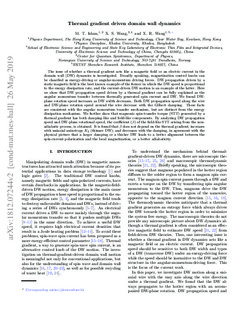| dc.contributor.author | Torikul, M. T. | |
| dc.contributor.author | Wang, Xiansi | |
| dc.contributor.author | Wang, X. R. | |
| dc.date.accessioned | 2019-08-22T08:12:20Z | |
| dc.date.available | 2019-08-22T08:12:20Z | |
| dc.date.created | 2019-06-28T12:59:48Z | |
| dc.date.issued | 2019 | |
| dc.identifier.issn | 0953-8984 | |
| dc.identifier.uri | http://hdl.handle.net/11250/2609758 | |
| dc.description.abstract | The issue of whether a thermal gradient acts like a magnetic field or an electric current in the domain wall (DW) dynamics is investigated. Broadly speaking, magnetization control knobs can be classified as energy-driving or angular-momentum driving forces. DW propagation driven by a static magnetic field is the best known example of the former in which the DW speed is proportional to the energy dissipation rate, and the current-driven DW motion is an example of the latter. Here we show that DW propagation speed driven by a thermal gradient can be fully explained as the angular momentum transfer between thermally generated spin current and DW. We found DW-plane rotation speed increases as DW width decreases. Both DW propagation speed along the wire and DW-plane rotation speed around the wire decrease with the Gilbert damping. These facts are consistent with the angular momentum transfer mechanism, but are distinct from the energy dissipation mechanism. We further show that magnonic spin-transfer torque (STT) generated by a thermal gradient has both damping-like and field-like components. By analyzing DW propagation speed and DW-plane rotational speed, the coefficient ( ) of the field-like STT arising from the non-adiabatic process, is obtained. It is found that does not depend on the thermal gradient; increases with uniaxial anisotropy (thinner DW); and decreases with the damping, in agreement with the physical picture that a larger damping or a thicker DW leads to a better alignment between the spin-current polarization and the local magnetization, or a better adiabaticity. | nb_NO |
| dc.language.iso | eng | nb_NO |
| dc.publisher | IOP Publishing | nb_NO |
| dc.title | Thermal gradient driven domain wall dynamics | nb_NO |
| dc.type | Journal article | nb_NO |
| dc.type | Peer reviewed | nb_NO |
| dc.description.version | acceptedVersion | nb_NO |
| dc.source.volume | 31 | nb_NO |
| dc.source.journal | Journal of Physics: Condensed Matter | nb_NO |
| dc.source.issue | 45 | nb_NO |
| dc.identifier.doi | 10.1088/1361-648X/ab27d6 | |
| dc.identifier.cristin | 1708620 | |
| dc.description.localcode | This is an author-created, un-copyedited version of an article accepted for publication/published in [Journal of Physics: Condensed Matter]. IOP Publishing Ltd is not responsible for any errors or omissions in this version of the manuscript or any version derived from it. The Version of Record is available online at 10.1088/1361-648X/ab27d6 | nb_NO |
| cristin.unitcode | 194,66,20,0 | |
| cristin.unitname | Institutt for fysikk | |
| cristin.ispublished | true | |
| cristin.fulltext | preprint | |
| cristin.qualitycode | 1 | |
